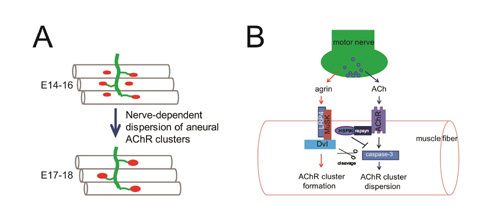Time:2014-03-14
The clustering of neurotransmitter receptors is a hallmark for postsynaptic differentiation. At the vertebrate neuromuscular junction (NMJ), the clustering of AChRs is believed to be regulated by positive and negative factors, which determine strengthening of innervated AChR clusters and dispersion of aneural clusters, respectively. The interplay between positive and negative signals results in the precise matching of motor nerve terminals to individual postsynaptic sites enriched with AChRs. However, the intracellular interplay between positive and negative signaling remains elusive.
In this study, Dr. LUO Zhenge’s lab reported that caspase-3, the effector protease involved in apoptosis, mediates elimination of AChR clusters. They found that caspase-3 was activated by cholinergic stimulation of cultured muscle cells without inducing cell apoptosis and this activation was prevented by agrin. Interestingly, inhibition of caspase-3 attenuated ACh agonist- induced dispersion of AChR clusters. Furthermore, they identified Dishevelled1 (Dvl1), a Wnt signaling protein involved in AChR clustering, as the substrate of caspase-3. Blocking Dvl1 cleavage prevented induced dispersion of AChR clusters. Finally, inhibition or genetic ablation of caspase-3 or expression of caspase-3-resistant form of Dvl1 caused stabilization of aneural AChR clusters. Thus, caspase-3 plays an important role in the elimination of postsynaptic structures during the development of NMJs.
This study was mainly carried out by graduate student WANG Jinyuan, Dr. CHEN Fei and colleagues under the supervision of Dr. LUO Zhenge, with the help of Dr. ZHANG Xiaohui’s laboratory and other colleagues in ION. This work entitled “Caspase-3 Cleavage of Dishevelled Induces Elimination of Postsynaptic Structures” was published online in the journal Developmental Cell on March 13, 2014. This study was supported by grants from National Natural Science Foundation and the Ministry of Science and Technology of China.

(A) Schematic illustration of two overlapping steps in NMJ development. Green, presynaptic nerves; Red, postsynaptic AChR clusters.
(B) Working model. ACh-activation of caspase-3 leads to the cleavage of MuSK signaling protein Dvl1, resulting in the elimination of aneural AChR clusters. Agrin inhibits ACh-induced activation through HSP90β, leading to the stabilization of innervated clusters.
 附件下载:
附件下载: